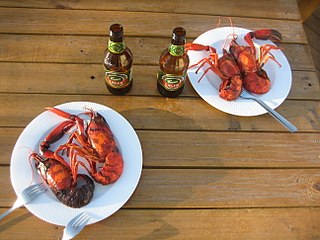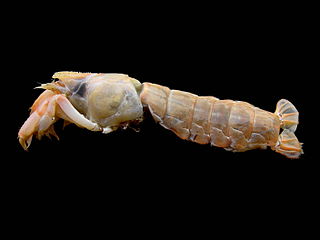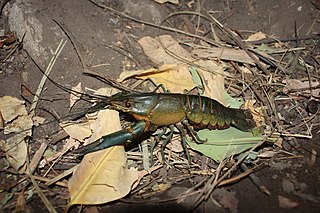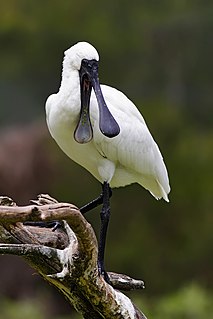
Crayfish are freshwater crustaceans resembling small lobsters. In some locations, they are also known as crawfish, craydids, crawdaddies, crawdads, freshwater lobsters, mountain lobsters, rock lobsters, mudbugs, or yabbies. Taxonomically, they are members of the superfamilies Astacoidea and Parastacoidea. They breathe through feather-like gills. Some species are found in brooks and streams, where fresh water is running, while others thrive in swamps, ditches, and paddy fields. Most crayfish cannot tolerate polluted water, although some species, such as Procambarus clarkii, are hardier. Crayfish feed on animals and plants, either living or decomposing, and detritus.
Yabby is a name given in Australia to two different kinds of crustacean:

The Namoi River, a major perennial river that is part of the Barwon catchment of the Murray–Darling basin, is located in the Northern Tablelands and North West Slopes districts of New South Wales, Australia.

The Parastacidae are the family of freshwater crayfish found in the Southern Hemisphere. The family is a classic Gondwana-distributed taxon, with extant members in South America, Madagascar, Australia, New Zealand, and New Guinea, and extinct taxa also in Antarctica.

Marron is a name given to two closely related species of crayfish in Western Australia. Formerly considered a single species, it is now recognised as comprising two species, the critically endangered Cherax tenuimanus, and the species that is outcompeting it, C. cainii.

Cherax, commonly known as yabby/yabbies in Australia, is the most widespread genus of fully aquatic crayfish in the Southern Hemisphere. Various species of cherax may be found in both still and flowing bodies of freshwater across most of Australia and New Guinea. Together with Euastacus, it is also the largest crayfish genus in the Southern Hemisphere.

Thalassinidea is a former infraorder of decapod crustaceans that live in burrows in muddy bottoms of the world's oceans. In Australian English, the littoral thalassinidean Trypaea australiensis is referred to as the yabby, frequently used as bait for estuarine fishing; elsewhere, however, they are poorly known, and as such have few vernacular names, "mud lobster" and "ghost shrimp" counting among them. The burrows made by thalassinideans are frequently preserved, and the fossil record of thalassinideans reaches back to the late Jurassic.

Cherax quadricarinatus is an Australian freshwater crayfish.

The common yabby is an Australian freshwater crustacean in the Parastacidae family. It is listed as a vulnerable species of crayfish by the International Union for Conservation of Nature (IUCN), though wild yabby populations remain strong, and have expanded into new habitats created by reservoirs and farm dams.

The royal spoonbill also known as the black-billed spoonbill, occurs in intertidal flats and shallows of fresh and saltwater wetlands in Australia, New Zealand, Indonesia, Papua New Guinea, and the Solomon Islands. It has also been recorded as a vagrant in New Caledonia. The royal spoonbill lives in wetlands and feeds on crustaceans, fish and small insects by sweeping its bill from side to side. It always flies with its head extended. Widespread throughout its large range, the royal spoonbill is evaluated as Least Concern on the IUCN Red List of Threatened Species.

The yellow-billed spoonbill is a gregarious wading bird of the ibis and spoonbill family, Threskiornithidae. It is native to Australia, and is a vagrant to New Zealand, Lord Howe Island and Norfolk Island.
Cherax quinquecarinatus is a small freshwater crayfish endemic to the south-west corner of Australia. It is one of two species known as gilgie, or jilgi, which is a seasonal food source for people of the region. Gilgies are found throughout a biogeographically isolated region of the coastal south of Western Australia and are significant in the ecology of aquatic systems of that bioregion.

The Perth Wetlands, also known as the Perth Great Lakes or the Great Lakes District, was a collection of fresh-water wetlands, swamps and lakes located on the Swan Coastal Plain north of the city of Perth in Western Australia. Over a period of 80 years from the first British settlement in Western Australia in 1829 most of the wetlands were reclaimed for use as housing, parks and market gardens.

Crayfish are eaten all over the world. Like other edible crustaceans, only a small portion of the body of a crayfish is edible. In most prepared dishes, such as soups, bisques and étouffées, only the tail portion is served. At crawfish boils or other meals where the entire body of the crayfish is presented, other portions, such as the claw meat, may be eaten.

The eastern swamp crayfish is a species of small freshwater crayfish from coastal New South Wales, Australia. It is distinguished from related species by large genital papilla on the males, large raised postorbital ridges, a laterally compressed carapace, and elongated chelae.
Avery Hutley, better known by the name of her musical project marumaru or her former project Cherax Destructor, is an Australian electronic music producer, songwriter, comedian, and manga translator based in Kyoto. She has also released work under the pseudonyms ᴅᴀɪᴋᴜ ɪɴᴅᴜsᴛʀɪᴇs, helpful kappa and lucky beast, and is a member of the Australian pop rock band Dr. Spaceman.

Cherax snowden is a species of crayfish from West Papua in Indonesia. In the wild, they live in freshwater river tributaries. It is popular as a freshwater aquarium pet across Asia, Europe, and North America because of its orange-tipped claws. Specimens were previously misidentified as members of Cherax holthuisi, also from West Papua.

Cherax preissii, the common koonac, is a Western Australian freshwater crustacean in the Parastacidae family.














